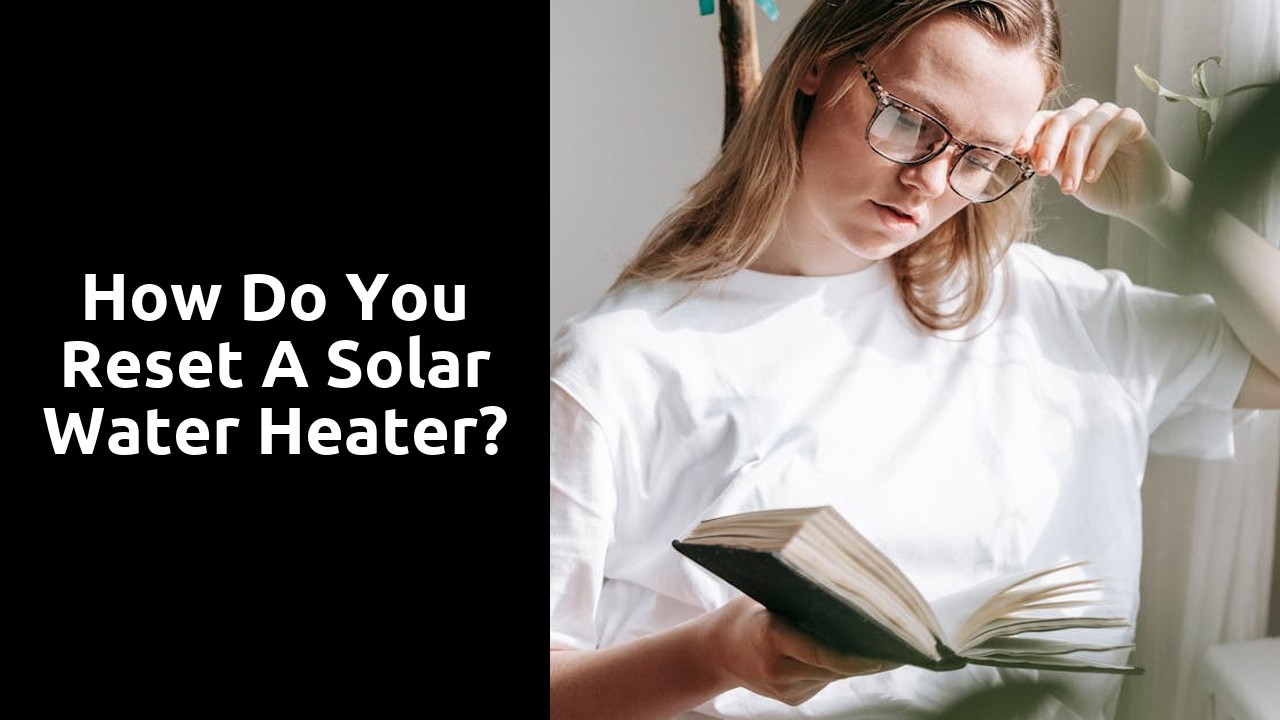 Releasing Excess Pressure Safely
Releasing Excess Pressure SafelyEvaluating the Antifreeze Levels
Table Of Contents
Steps to Reset a Solar Water HeaterWhen troubleshooting a solar hot water system, reviewing the electrical connections is crucial to ensure the system operates efficiently. Begin by examining all wires for any signs of damage or wear. Look for frayed wires, corrosion, or loose connections that may be causing issues with the system's electrical supply.
To reset a solar water heater, first, look for any error codes on the system display. If you notice any codes, refer to the manufacturer's manual for guidance on how to address them. Error codes are essential indicators of potential issues within the system, providing valuable insight into what may be causing the malfunction. By identifying and addressing these errors promptly, you can efficiently troubleshoot and reset your solar hot water system.Next, check the connections to the controllers, pumps, and sensors to make sure they are securely in place. Loose connections can lead to disruptions in the system's functioning. If any connections appear loose or damaged, tighten them or replace them as necessary to prevent any further complications. Proper maintenance of the electrical components is essential for the overall performance of the Solar Hot Water System Troubleshooting.
Next, proceed to bleed air from the system to ensure optimal functionality. Air bubbles may accumulate within the pipes, hindering the flow of water and affecting the heating process. To remove air from the system, carefully open the designated air release valve and allow the trapped air to escape. This simple yet crucial step can help restore the system's efficiency and performance, enabling your solar water heater to operate effectively.Inspecting Wires for Damage
Look for Error Codes
When troubleshooting a solar hot water system, one of the first steps is to look for error codes. Error codes are indicators that help identify specific issues within the system. These codes are usually displayed on the control panel or interface of the solar water heater, providing insight into the source of the problem. Familiarising yourself with the error codes can streamline the diagnostic process and assist in resolving the issue efficiently.Inspecting wires for damage is a crucial step in the process of troubleshooting a solar hot water system. Damaged wires can result in electrical malfunctions that may disrupt the system's efficiency. To begin, carefully examine all wires connected to the system for any visible signs of wear, fraying, or corrosion. Look out for areas where the insulation may be compromised or where the wires appear to be exposed.
By noting down the error code displayed on the solar water heater, you can refer to the system's manual or contact a professional for further guidance. Understanding the error code is crucial in pinpointing where the fault lies within the solar hot water system. If you encounter an error code that is unfamiliar or persists after attempting basic troubleshooting steps, it may be necessary to seek assistance from a certified technician to assess and rectify the underlying problem.Additionally, check the connection points of the wires to ensure they are securely fastened and free of any debris or corrosion. Any loose connections or faulty wiring can lead to interruptions in the system's operation. If any damaged wires are found during the inspection, they should be promptly repaired or replaced to prevent further issues with the system. Regularly inspecting the wires for damage is a proactive measure that can help maintain the functionality and longevity of your solar hot water system.
Steps to Reset a Solar Water HeaterEvaluating the Antifreeze Levels
When assessing the antifreeze levels in your solar hot water system, ensure that you consult the manufacturer's guidelines for the recommended type and concentration. Should the levels be insufficient, or the antifreeze appears degraded, it is imperative to add or replace it promptly. Remember that accurate levels of antifreeze help in safeguarding the system components and promoting its longevity. Regular maintenance and monitoring of the antAfter completing the task of checking for error codes in your solar hot water system troubleshooting, the next step is to bleed air from the system. When air gets trapped in the system, it can hinder the proper flow of water and inhibit the system from functioning optimally. To bleed the air from your solar hot water system, start by locating the bleed valves on your system. These valves are typically found near the top of the solar collector or on the pipes connected to the system. ifreeze levels are integral aspects of effective Solar Hot Water System Troubleshooting.
Once you have located the bleed valves, use a screwdriver or wrench to carefully open them. Be cautious as hot water and steam may be released. Allow the air to escape from the system until you see a steady flow of water coming out of the valves. Close the valves securely once all the air has been bled from the system. By bleeding the air from your solar hot water system, you can ensure that it operates efficiently and effectively, providing you with reliable hot water for your needs.FAQS
Steps to Reset a Solar Water HeaterHow can I test the Pressure Relief Valve on my solar hot water system?
Resetting a solar water heater can be a simple process if done correctly. When encountering issues with your solar hot water system, the first step is to look for any error codes displayed on the control panel. Error codes can provide valuable information on what might be malfunctioning within the system. Once the error code has been identified, refer to the user manual for guidance on how to address the specific issue.To test the Pressure Relief Valve, lift the lever on the valve to release a small amount of water. If water does not come out or the valve is leaking, it may need to be replaced.
After identifying any error codes and attempting to rectify them, the next step in resetting your solar water heater involves bleeding air from the system. Air pockets in the system can disrupt the flow of water and hinder the heating process. By bleeding the air from the system, you can ensure that water circulates efficiently, allowing the solar water heater to function optimally. This process can help in resolving common issues with solar hot water systems and is an essential part of solar hot water system troubleshooting.What is the correct way to release excess pressure from my solar hot water system safely?
Test the Temperature SensorsTo release excess pressure safely, turn off the power to the system, then carefully open the Pressure Relief Valve to allow any built-up pressure to escape.
To ensure your solar hot water system is functioning optimally, it is essential to periodically test the temperature sensors. These sensors are vital in regulating the temperature of the water in the system and can greatly impact the efficiency of your solar hot water heater. Start by locating the temperature sensors on your system; they are usually situated near the tank or on the piping. Check for any visible damage or corrosion that may be affecting their performance.How should I review the electrical connections on my solar hot water system for troubleshooting purposes?
Next, you can test the temperature sensors by using a multimeter to measure the resistance of the sensors. This will help determine if they are within the appropriate range for accurate temperature readings. If the sensors are not functioning correctly, they may need to be recalibrated or replaced to ensure the proper operation of your solar hot water system. Testing the temperature sensors is a crucial step in solar hot water system troubleshooting, as it can help identify and resolve any issues that may be affecting the performance of your system.When reviewing the electrical connections, ensure that all connections are secure and free from corrosion. Check for any signs of damage or wear on the wires.
